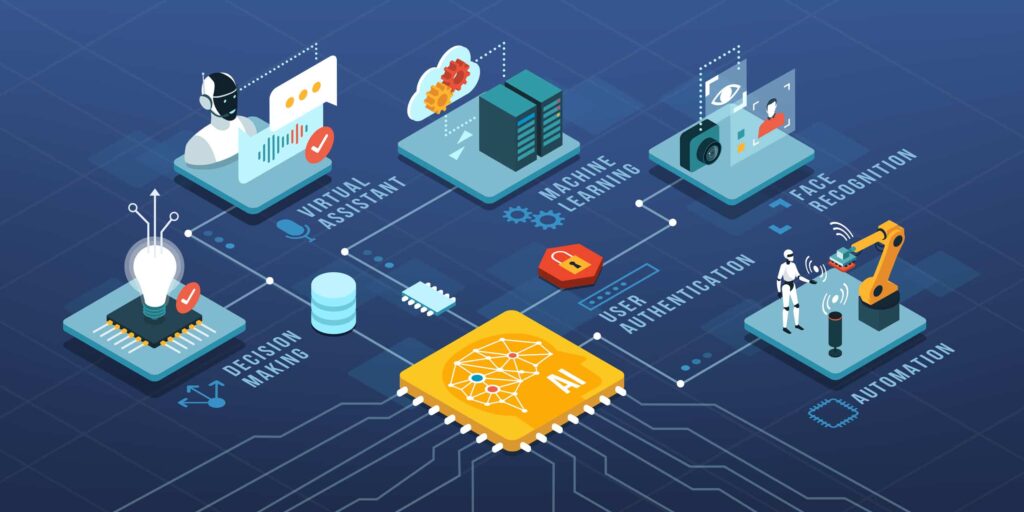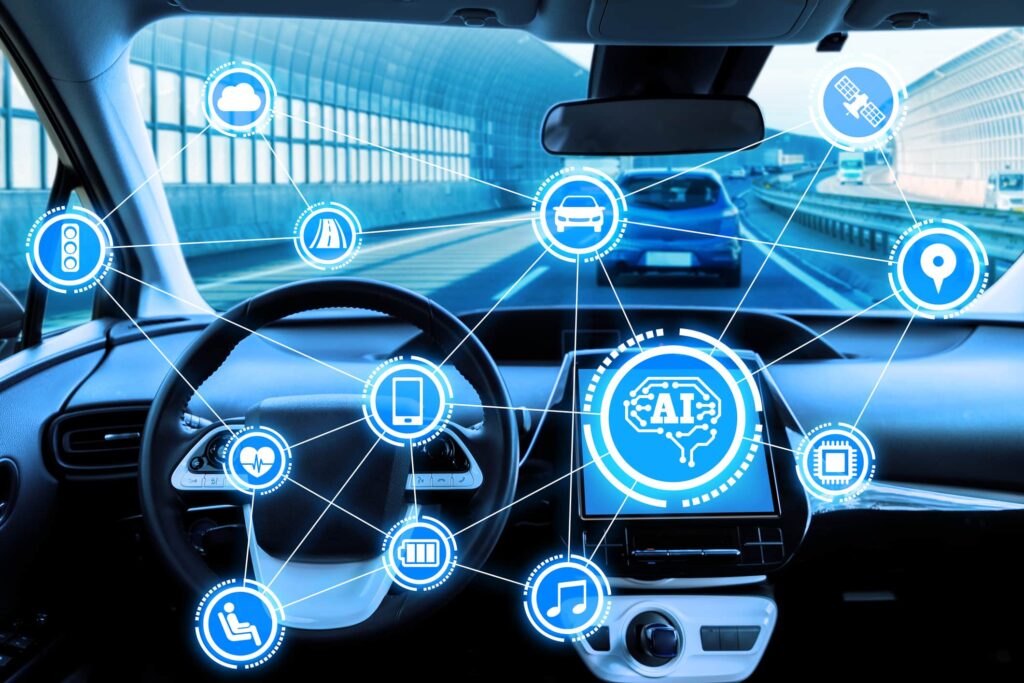
Machine learning, often abbreviated as ML, is a remarkable field of technology that allows computers to learn from data and make predictions or decisions without being explicitly programmed. Imagine teaching a computer to recognize handwritten digits or predict the price of a house based on various factors – that’s the magic of machine learning. This blog will take you through all the aspects of Machine Learning. Ready to discover the marvel Machine Learning technology is? Come dive in!
Table of Contents
What is Machine Learning?
The technical definition of Machine Learning can be quoted as, “Machine Learning (ML) is a subfield of artificial intelligence (AI) that focuses on the development of algorithms and statistical models, allowing computer systems to improve their performance on a specific task through learning from and analyzing data.”
Machine Learning is a fascinating part of Artificial Intelligence that makes computers smart in learning from new data and experiences without us having to tell them exactly what to do. It’s like teaching a computer to ride a bicycle by showing it how rather than giving it a step-by-step manual. Let’s dive into what makes Machine Learning special.
Imagine you have a smartphone that can suggest movies you might enjoy watching based on the movies you’ve liked in the past. That’s Machine Learning in action. The more movies you rate, the better your phone becomes at predicting what you’ll like.
Machine Learning algorithm is like a magical chef. You give it recipes (data), and it learns how to create delicious dishes (predictions or decisions). For instance, it can help doctors predict diseases based on patient data, assist in self-driving cars making safe decisions, or even recommend products on shopping websites.
Here’s the secret sauce: Machine Learning uses mathematical algorithms to find patterns in data. When you show it lots of pictures of cats and dogs with labels, it learns to tell them apart. So, when you show it a new picture, it can say whether it’s a cat or a dog.
Why is Machine Learning Important?
Machine Learning (ML) plays a pivotal role in today’s world due to its significance in two key areas: data-driven decision-making and automation with predictive analysis.
Data-Driven Decision-Making:
In the digital age, businesses and organizations are inundated with vast data. Extracting valuable insights from this data is essential for informed decision-making. Machine learning is the cornerstone of data-driven decision-making for several reasons.
- Handling Big Data: Machine learning can process and analyze colossal datasets that would be humanly impossible to manage. For instance, in the healthcare sector, ML models can process patient records to predict disease outbreaks, enabling timely interventions.
- Personalization: ML algorithms power recommendation systems like those of Netflix and Amazon. They analyze user preferences and behaviors to suggest movies or products tailored to individual tastes. This personalization enhances user satisfaction and drives business success.
- Business Intelligence: Organizations use ML to uncover hidden patterns and trends within their data. For instance, in finance, ML models can detect fraudulent transactions by identifying unusual patterns in real-time, safeguarding financial assets.
Automation and Predictive Analysis:
Automation is a cornerstone of efficiency in many industries, and predictive analysis is the backbone of this automation. Machine learning plays a pivotal role in automating processes and making predictions.
- Manufacturing: In industries such as automobile manufacturing, ML algorithms monitor machinery and predict maintenance needs. This minimizes downtime and maximizes production efficiency, saving both time and money.
- Financial Services: ML is crucial for banks and financial institutions to predict stock market trends and approve loans. It automates risk assessment, reducing the time required for decision-making while optimizing resource allocation.
- Healthcare: In healthcare, ML models analyze patient data to predict disease outcomes and recommend treatment plans. This not only saves lives but also reduces healthcare costs through early intervention.
In essence, machine learning empowers us to harness the potential of data, make informed decisions, and automate tasks that were once labor-intensive. Its importance is underscored by its ability to drive innovation, increase efficiency, and save resources across various domains, making it an invaluable tool in today’s data-driven and automated world.
What are the different types of machine learning?
There are several types of machine learning systems, each with its unique way of learning and solving problems.
Supervised Machine Learning:
Definition:
Supervised Learning involves training machine learning algorithms on labeled datasets. Labeled data means that each input example has a corresponding output or target value, which serves as a reference or “answer key” for the algorithm.
Supervised Machine Learning is like having a teacher guiding the computer. Imagine you are teaching a computer to recognize different types of fruits, like apples and bananas. You show it pictures of apples and bananas and tell it which is which. The computer learns to recognize them based on your guidance. Later, showing it a new picture can tell you if it’s an apple or a banana.
Examples:
- Image Classification: You provide a model with images of cats and dogs; each image is labelled with the correct category. The model learns to distinguish between cats and dogs.
- Spam Detection: Emails are labeled as spam or not spam (ham). The model learns to classify incoming emails based on patterns identified from the labeled data.
Use Cases:
Supervised Learning is widely used in tasks such as image recognition, speech recognition, medical diagnosis, and recommendation systems.
Unsupervised Machine Learning:
Definition:
Unsupervised Learning involves training machine learning algorithms on unlabeled datasets. Unlike supervised Learning, there are no predefined output labels, and the algorithm must find patterns and structure within the data on its own.
Unsupervised Machine Learning is like letting the computer explore and find its own patterns. Imagine you give the computer a bunch of mixed-up fruits without telling it what they are. It starts sorting them based on their similarities. It might group all the apples and all the bananas without knowing their names.
Examples:
- Clustering: Grouping similar customer profiles based on their purchase behavior without knowing how many clusters there should be in advance.
- Dimensionality Reduction: Reducing the number of variables in a dataset while preserving its essential features, such as using Principal Component Analysis (PCA).
Use Cases:
Unsupervised Learning is applied in customer segmentation, anomaly detection, and data compression.
Semi-Supervised Machine Learning:
Definition:
Semi-supervised Learning is a blend of supervised and unsupervised Learning. It uses a small amount of labeled data and a more significant amount of unlabeled data to train models. The labeled data helps guide the learning process while leveraging the benefits of unlabeled data.
Semi-supervised Machine Learning is a bit of both. It’s like teaching a computer using a mix of labeled and unlabeled input data. For instance, you teach it to recognize a few spoken words (labeled), and then it learns from a big pile of unmarked words. It becomes smart enough to recognize the new words, even if you didn’t specifically teach them.
Examples:
- Text Classification: Training a model to categorize news articles as sports, politics, or entertainment using both labeled articles and a larger pool of unlabeled text.
- Speech Recognition: A model may be trained with a small dataset of transcribed speech (labeled) and then fine-tuned with a large dataset of unlabeled speech.
Use Cases:
Semi-supervised Learning is valuable when obtaining labeled data is expensive or time-consuming. It’s used in scenarios like sentiment analysis and fraud detection.
Reinforcement Machine Learning:
Definition:
Reinforcement learning is a type of machine learning where an agent interacts with an environment and learns by receiving rewards or penalties for its actions. The goal is to find the best strategy or policy to maximize cumulative rewards over time.
Reinforcement Learning is how computers learn by trial and error. Imagine you’re training a dog. When it does something right, you reward it; when it does something wrong, you give it a little nudge to learn from its mistakes. Similarly, computers learn through reward and punishment.
Examples:
- Game Playing: Teaching a computer program to play chess, Go, or video games, where it learns from trial and error and adjusts its strategy to win more often.
- Autonomous Vehicles: Training self-driving cars to make decisions like accelerating, braking, and steering to reach a destination safely.
Use Cases: Reinforcement learning is applied in robotics, autonomous systems, recommendation systems, and game-playing AI.
These different types of machine learning offer various tools and techniques for solving a wide range of problems. Depending on the nature of the data and the desired outcome, one type may be more suitable than others. In practice, many machine learning projects involve a combination of these types to achieve the best results.
What are the Essential Components of Machine Learning?
To grasp the core of ML, we must dive into its essential components: Algorithms, Data, and Models. Let’s unravel the mystery behind these elements in simple terms.
Algorithms: The Brain of Machine Learning
Imagine algorithms as the brains of ML. They are problem-solving tools that sift through data to find patterns, make predictions, or classify information. Just like how we learn from experiences, ML algorithms learn from data.
Example: Think of teaching a computer to identify fruits. You feed it countless images of apples, oranges, and bananas. The algorithm analyzes these images and learns to differentiate between them. It’s like a virtual fruit connoisseur!
There are various ML algorithms, each with its unique way of learning from data. For instance, decision trees make choices like a flowchart, while neural networks mimic neural networks, the human brain’s interconnected neurons. The choice of algorithm depends on the specific problem you want to solve.
Data: The Fuel for Machine Learning
Data is the lifeblood of ML. Without it, algorithms would be like hungry chefs without ingredients. Data is collected, cleaned, and processed to be fed into ML models. The quality of data strongly influences the performance of these models.
Example: Imagine you’re building a weather prediction system. You gather data from weather stations worldwide, including temperature, humidity, and wind speed. ML algorithms use this data to make accurate weather forecasts.
Data preprocessing is a crucial step involving tasks like data integration (combining data from different sources), cleaning (removing errors or inconsistencies), and transformation (formatting data for analysis). Without proper data handling, ML models can produce unreliable results.
Models: ML’s Decision-Makers
ML models are the products of algorithms trained on data. They’re like virtual experts who’ve learned the ropes and can now make predictions or decisions based on new information.
Example: Think of a model as a well-trained chef. After learning from countless recipes and ingredients, the chef can create delicious dishes from scratch. Similarly, an ML model can predict stock prices, recommend movies, or even diagnose diseases based on what it learned during training.
Creating an ML model involves experimenting with different algorithm settings and hyperparameters. It’s like tuning a musical instrument to produce the best sound. Once you have a well-tuned model, it can be deployed in real-world applications.
In summary:
Algorithms: These problem-solving tools learn from data and make decisions.
Data: It’s the raw material, carefully collected and prepared, on which ML algorithms work their magic.
Models: These are the knowledgeable outcomes of ML algorithms, capable of making predictions or classifications from labeled data.
To put it simply, algorithms learn from data to create models, which, in turn, can make informed decisions. This trio forms the foundation of Machine Learning, enabling computers to tackle complex tasks, from recognizing fruits to predicting the future.
Real-World Applications of Machine Learning
Machine Learning is not just a buzzword; it’s a transformative force reshaping various industries. Here are a few Real-World Applications of Machine Learning.
Healthcare: Predicting Illnesses and Personalizing Treatment

Imagine a world where doctors can predict illnesses before symptoms appear. Thanks to Machine Learning, we’re getting closer to that reality. Machine Learning algorithms analyze massive healthcare datasets, considering factors like genetics, lifestyle, and medical history. With this information, they identify patients at high risk of chronic diseases like diabetes or heart disease. Early intervention becomes possible, potentially saving lives and reducing healthcare costs.
Additionally, Machine Learning personalizes treatment plans. It tailors therapies based on an individual’s genetic makeup, ensuring patients receive precisely what they need. This level of precision has the potential to revolutionize medicine, making treatments more effective and reducing side effects.
Moreover, Machine Learning assists radiologists by interpreting medical images like X-rays and MRIs. Algorithms can identify anomalies or potential issues faster and more accurately than human eyes alone. This reduces human error, speeds up diagnoses, and improves patient outcomes.
Finance: Reducing Risks and Improving Decision-Making

In the world of finance, Machine Learning is a game-changer. It powers real-time fraud detection systems, scrutinizing transactions for suspicious activities. If a transaction looks fishy, your bank can immediately block your card and notify you, all thanks to ML algorithms working behind the scenes.
Machine Learning also automates trading strategies. It analyzes market and data points and makes split-second decisions to buy or sell stocks. This automation reduces human biases and ensures that trading is based on data, not emotions.
Another crucial application is credit risk evaluation. When you apply for a loan or credit card, Machine Learning algorithms assess your creditworthiness by analyzing your financial history. This leads to better lending decisions, ensuring that loans are given to those who can repay them.
Natural Language Processing (NLP): Bridging Language Barriers

NLP is a fascinating branch of Machine Learning that enables computers to understand and interact with human language. Think about AI chatbots—those friendly virtual assistants you encounter on websites. They use NLP to understand your questions and provide answers or assistance. This technology enhances customer service by providing instant responses and resolving queries 24/7.
Language translation services are another example of NLP in action. Google Translate, for instance, uses Machine Learning algorithms to translate text or speech from one language to another. This breaks down language barriers and fosters global communication, making the world feel a bit smaller.
Autonomous Vehicles: Navigating Safely

Picture self-driving cars cruising on the roads, making real-time decisions to ensure safe navigation. This is the promise of Machine Learning in the realm of autonomous vehicles. These cars use sensors like cameras, lidar, and radar to collect data about their surroundings. Machine Learning algorithms then process this data, making instantaneous decisions about speed, direction, and even braking.
Autonomous vehicles have the potential to revolutionize transportation. They could reduce traffic congestion accidents caused by human error and even provide more efficient transportation options. Companies like Tesla already use advanced driver-assistance systems driven by Machine Learning to make our roads safer.
Recommendation Systems: Personalized Suggestions
Have you ever wondered how platforms like Netflix or Amazon know exactly what you’d like? That’s the magic of recommendation systems powered by Machine Learning. These systems analyze your behavior and preferences to offer personalized suggestions.
For instance, when you watch a movie on Netflix, the platform uses a Machine Learning algorithm to understand your taste and recommends other movies or TV shows you might enjoy. Similarly, when you shop on Amazon, Machine Learning algorithms consider your browsing and purchase history to suggest products you might want to buy.
These recommendations not only enhance user experience but also benefit businesses. Users are more likely to make purchases or stay engaged when they receive tailored suggestions, increasing sales and customer loyalty.
Challenges in Machine Learning
Machine Learning and the big package of benefits also have their share of challenges. Here are some of the Challenges in Machine Learning.
Data Quality and Quantity
Machine Learning models thrive on data, but the quality and quantity of data can be significant challenges. Incomplete or biased datasets can lead to inaccurate predictions and skewed results. Ensuring data integrity and diversity is essential for reliable ML outcomes.
Interpretability
Complex ML models and intense learning neural networks are often perceived as “black boxes.” Understanding how these models make decisions is crucial, particularly in critical applications like healthcare and finance. Developing interpretable ML techniques is an ongoing challenge.
Ethical Concerns
Machine Learning can perpetuate biases in training data, leading to unfair outcomes. Ethical concerns arise when ML algorithms are used in hiring, criminal justice, and lending. Addressing prejudice and ensuring fairness in ML algorithms is essential to maintaining societal trust.
Scalability
Scaling ML models to handle large datasets and real-time processing can be resource-intensive. Developing scalable and efficient ML solutions remains challenging as data volumes grow, especially for organizations with limited computational resources.
Future of Machine Learning
Explainable AI (XAI)
Explainable AI is an emerging area in machine learning that focuses on making AI and ML models more transparent and interpretable. Understanding and trusting these systems will become increasingly important as AI systems become more integrated into decision-making processes.
XAI aims to provide insights into how ML models arrive at specific conclusions, helping users and stakeholders comprehend and verify the reasoning behind AI-driven decisions. This transparency is critical for ethical AI adoption and regulatory compliance.
AI in Healthcare
The future of healthcare holds tremendous promise for machine learning applications. Predictive analytics will continue to advance, enabling earlier disease detection and personalized treatment plans. Drug discovery will benefit from ML algorithms, accelerating the development of new medications and therapies.
Already rising, telemedicine will expand its reach with ML-powered diagnostic tools and remote patient monitoring, improving access to healthcare services worldwide.
AI for Sustainability
Addressing climate change and sustainability challenges is a global priority. Machine Learning will be vital in optimizing energy consumption, managing natural resources, and reducing environmental impact.
ML models will help optimize energy grids, predict and mitigate environmental disasters, and support sustainable agriculture and forestry practices. AI-driven insights will empower policymakers and organizations to make informed decisions for a more sustainable future.
Edge Computing
Edge AI, which involves processing data locally on devices rather than relying solely on cloud servers, is set to become more prevalent. Edge devices, equipped with machine learning capabilities, can analyze data in real-time, reducing latency and ensuring privacy.
This trend will enable applications such as smart homes, autonomous vehicles, and industrial automation to operate efficiently and securely without constant cloud connectivity.
Deep Learning
Deep Learning is a subfield of machine learning that focuses on neural networks with multiple layers, known as deep neural networks. These artificial neural networks are designed to mimic the structure and functioning of the human brain, making them suitable for handling complex tasks like image recognition, natural language understanding, and speech recognition.
Deep Learning has achieved remarkable breakthroughs in computer vision, enabling facial recognition, object detection, and autonomous driving. It has also revolutionized natural language processing, developing conversational AI, sentiment analysis, and machine translation.
Emerging Trends and What to Expect in the Next Decade
Federated Learning
Federated learning is a distributed machine learning approach that allows model training without centralizing data. It enhances privacy and security by keeping data on edge devices and only sharing model updates. This approach is ideal for applications like healthcare, where sensitive patient data must be protected.
Quantum Machine Learning
With their unprecedented computing power, Quantum computers will enable more powerful ML models. They can solve complex problems, such as optimizing supply chains, simulating molecular interactions for drug discovery, and enhancing cryptography.
AI Ethics and Regulations
As AI and ML become integral to society, regulations and ethical considerations will evolve. Governments and organizations will establish guidelines for responsible AI development and use. Ethical AI, bias mitigation, and transparency will be at the forefront of AI research and development.
Robotic Process Automation (RPA)
Combining RPA with ML will automate repetitive tasks across various industries. From data entry and customer support to document processing, ML-powered RPA will streamline operations, reduce errors, and free up human employees to focus on more creative and strategic tasks.
Frequently Ask Questions (FAQ's)
What is the difference between AI and ML?
AI encompasses broader concepts of machines mimicking human intelligence, while ML is a subset of AI focused on training models to make predictions.
How can businesses implement these machine learning techniques?
Businesses can implement ML by collecting quality data, selecting appropriate algorithms, and employing skilled data scientists.
What are some ethical concerns in the machine learning model?
Ethical concerns include algorithmic bias, privacy invasion, and the potential for job displacement.
How will Machine Learning impact job markets?
Machine Learning may automate specific tasks but create new roles in data science, AI ethics, and AI strategy.
What are the limitations of deep Learning?
Deep Learning requires substantial data and computational power, and it may only sometimes generalize well to new, unseen data.
